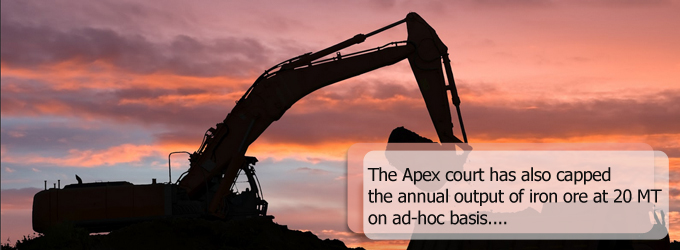|
The Supreme Court lifted an 18-month old ban on iron ore mining in Goa, in April 2014. Though the apex court’s verdict was welcomed by all mining companies, it will take some time before the companies can resume mining in the state.

The deemed leases of mining companies in Goa expired in 1987, and the 20-year renewal period of these leases expired in 2007. The Supreme Court, in its order, held that all mining leases in Goa, including those of Sesa Sterlite, expired in 2007 and hence, the mining activity carried out after 2007 was illegal. Additionally, the Apex court has directed the state government to firm up a policy for granting fresh leases to the present deemed leaseholders.
Thus, no mining operations can be carried out without renewal or execution of mining lease deeds by the state government. The mining companies will need to apply for new leases and require fresh environmental and forest clearances.
The Apex court has also capped the annual output of iron ore at 20 million tonne on an ad-hoc basis. The court has asked an expert panel to give its final recommendation on the annual excavation cap from Goa mines, within six months.
Also, if experiences from the neighbouring state of Karnataka are any indications, then the resumption of mining operations will not take place anytime soon. The Apex court had banned illegal mining in Karnataka in July 2011. And even though a partial resumption of mines was allowed in April 2013, mining in the state has still not returned to normal. Most mines in Karnataka are facing delay in resuming operations for want of statutory clearance.
The state is yet to achieve the 30 million tpa output fixed by the Supreme Court. The court had allowed 115 mines to resume operations, but only 22 have done so, which together produce 9.7 million tpa. This, along with public sector miner NMDC’s production of 8.5 million tonne, takes the total output from the state to only 18 million tonne.
Sesa Sterlite, which has secured all the requisite clearances for mining in Karnataka, only recently resumed iron ore mining in Karnataka in December 2013, after a gap of more than two years. Industry expects similar delays in Goa.
There are 93 operating mines in Goa, including major miners like Sesa Sterlite, VM Salgaocar & Bro, and Fomento Resources. Sesa Sterlite, the largest mining company in Goa that produced around 16 million tpa of iron ore until the ban was imposed, will be the biggest beneficiary.
Before the Supreme Court issued a blanket ban in September 2012, Goa-based miners used to produce around 45 million tonne annually and exported 90 per cent of it. These exports from Goa accounted for more than half of India’s total iron ore exports. India used to export more than 100 million tonne of iron ore a year, mainly to China, before the mining bans were imposed in Goa and Karnataka.
While the Supreme Court banned ore mining activities in Karnataka and Goa, a blanket ban was imposed by the Orissa state government on iron ore exports in Orissa, since October 2012.
Mining is allowed only for captive use in the state.
These bans drastically slashed India’s exports to 12.57 million tonne during the April-February period of 2013-14 and 17.35 million tonne in the same period of 2012-13. As a result, India, once the world’s third largest exporter, turned into a net importer of iron ore in recent times. The lifting of the ban may not reverse this trend to its previous glory immediately but is likely to ease the dependence on imports in the coming months.
Although some quantity of iron ore is found in several parts of the country, a major part of the reserves are highly concentrated in a few selected areas. Six of the 29 Indian states i.e. Chhattisgarh, Goa, Jharkhand, Karnataka, Madhya Pradesh and Orissa account for over 95 per cent of the total reserves of India. Iron ore production in India has come down from 213 million tonne in 2008-09 to 136 million tonne in 2012-13 due to a ban on mining in Karnataka and Goa, and a partial ban in Orissa. Now, with the ban being lifted in Karnataka and Goa, and mining operations resuming in Karnataka, production in 2014-15 is expected to go up to 150 million tonne.
|